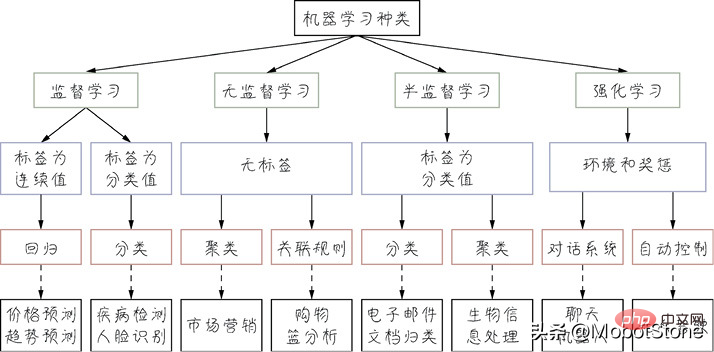Home >Technology peripherals >AI >What are the applications of machine learning?
What are the applications of machine learning?
- 王林forward
- 2023-05-08 10:58:083156browse
Two major application scenarios of machine learning—regression and classification
Regression and classification are the two most common types of machine learning problems, as shown in the figure below.

Regression problems are usually used to predict a value whose label values are continuous. For example, predict any continuous trends and values such as house prices and future weather. The more common regression algorithms are linear regression algorithms and neural networks in deep learning.
The classification problem is to label things with a category label, and the result is a discrete value, which is an option in the category. For example, determining whether the animal on a picture is a cat or a dog. Classification includes binary classification and multivariate classification, and there is only one final correct result for each class. Classification is a classic application field of machine learning. Many machine learning algorithms can be used for classification, including the most basic logistic regression algorithm, the classic decision tree algorithm, and neural networks in deep learning. There are also multi-label classification problems derived from multi-category classification. Typical applications include the automatic labeling of names when uploading photos on social networking sites, and recommendation systems - recommending multiple products to the same user on a website or app, or Recommend a certain product to multiple users.
Other application scenarios of machine learning
Of course, in addition to regression problems and classification problems, there are many application scenarios of machine learning. For example, the most common clustering problem in unsupervised learning is to divide data into different clusters according to the nature of their features without labels (in fact, it is data classification); another type of unsupervised learning is association Rules by which the influence relationships between features can be found.
Another example is time series, which refers to a data set whose internal structure changes regularly over time, such as trend data, data that changes with seasons, etc. The time series problem is actually a regression problem closely related to time and period. Specific application scenarios include predicting fluctuations in financial markets, inferring solar activity, tides, weather and even the birth of stars and the formation of galaxies, predicting the spread of epidemic diseases, etc.
There is also structured output. Usually machine learning outputs an answer or option, but sometimes it is necessary to output a structure through learning. What does that mean? For example, in speech recognition, the machine outputs a sentence. The sentence has a standard structure, not just the numbers 0 to 9 (recognizing 0 to 9 is a classification problem). This is a step further than ordinary classification problems. Specific application scenarios include speech recognition - outputting sentences with correct grammatical structure, and machine translation - outputting articles that comply with regulations.
The goal of some machine learning problems is not to solve problems, but to make the world more colorful. Therefore, AI can also perform the work done by artists, such as the following. Google's Dreamwork can combine the styles of two pictures for artistic style migration. Generative adversarial network GAN can create pictures that look real. Mining the latent space of digital feature vectors to create music, news, stories, etc.
We can call this machine learning application generative learning.
There are also times when the goal of machine learning is to make decisions, which are called decision-making problems. Decision-making problems are still essentially classification problems, because each decision actually uses the most appropriate behavior to classify a certain state of the environment. For example, the direction (left, center, right) in autonomous driving and the landing point in Go are still one of the 19×19 categories. Specific application scenarios include autonomous driving, intelligent agents playing games, robots playing chess, etc. In many decision-making problems, machines must learn which decisions are effective and can bring rewards, which decisions are ineffective and will bring negative returns, and which ones are beneficial to long-term goals. Therefore, reinforcement learning is a common technique in this case.
In general, the trick of machine learning is to understand your own problem and choose the best machine learning method (algorithm) for your problem, that is, to find which technology is most likely to be suitable for this problem. Condition. If you can connect scenarios or tasks with appropriate technologies, you can have an idea when you encounter a problem and quickly locate a solution. The following figure connects some common machine learning application scenarios and machine learning models

The above is the detailed content of What are the applications of machine learning?. For more information, please follow other related articles on the PHP Chinese website!
Related articles
See more- Technology trends to watch in 2023
- How Artificial Intelligence is Bringing New Everyday Work to Data Center Teams
- Can artificial intelligence or automation solve the problem of low energy efficiency in buildings?
- OpenAI co-founder interviewed by Huang Renxun: GPT-4's reasoning capabilities have not yet reached expectations
- Microsoft's Bing surpasses Google in search traffic thanks to OpenAI technology

